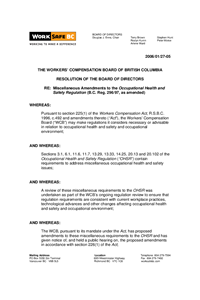BOD Decision -2006/01/27-05 – Miscellaneous Amendments to Occupational Health & Safety Regulation
At its January 2006 meeting, the Board of Directors approved several resolutions amending the Occupational Health and Safety Regulation. These approved amendments relate to the public hearing conducted in the fall of 2005.
The following amendments have been included in one resolution:
Part 3, Rights and Responsibilities
Occupational Health and Safety Programs
Section 3.1, When are they required:
The amendment clarifies the intent of a March 2004 regulatory amendment, which resulted in an inadvertent exemption of employers who have a large workforce but a small number of workers at each worksite from having an occupational health and safety program as required prior to March 30, 2004.
Part 6, Substance Specific Requirements
Section 6.1 (Definitions):
Section 6.1 of the Occupational Health and Safety Regulation references “WCB method 0205” as a method for quantifying the amount of asbestos in an air sample. With the elimination of the Workers’ Compensation Board (“WCB”) laboratory in 2001, the WCB no longer supports WCB sampling/analytical methods. The amendment replaces the reference to WCB Method 0205 with a reference to the National Institute for Occupational Safety and Health (NIOSH) Method 9002 or other method acceptable to the WCB.
Part 11, Fall Protection – Section 11.6, Anchors
Part 13, Ladders, Scaffolds and Temporary Work Platforms –
Section 13.33, Fall protection:
The amendment clarifies the intent of existing fall protection requirements which came into effect January 1, 2005 by revising the application of the requirement to include personal fall protection systems. As well, the requirements for a temporary fall arrest system and a permanent anchor have been placed in separate subsections. A consequential amendment to section 13.33 (1) was required as a result of this change.
Part 11, Fall Protection
Section 11.7, Temporary horizontal lifelines:
The amendment deletes the term “drawings” from the temporary horizontal lifeline requirements that came into effect January 1, 2005. The term “drawings” implies that the manufacturer or the engineer will develop formal drawings, whereas written instructions may be adequate and appropriate.
Part 13, Ladders, Scaffolds and Temporary Work Platforms
Section 13.29, Hoisting and lowering work platforms:
The amendment is consequential to the regulatory amendments effective January 1, 2005, to reflect that some types of work platform hoists do not have lower limit travel devices and to allow for work procedures acceptable to the Workers’ Compensation Board where such devices are not practicable.
Part 14, Cranes & Hoists
Section 14.25, Two-block prevention:
Effective January 1, 2005, section 13.98, regarding two-block prevention, was repealed, and section 13.28 enacted to address two-blocking. The change is a consequential amendment repealing section 14.25, which is a duplication of repealed section 13.98.
Part 20, Construction, Excavation and Demolition
Section 20.13, Thrust-out crane landing platforms:
The amendment recognizes the increased capacity of cranes in relation to landing platforms and introduces requirements to ensure that landing platforms are not overloaded.
Part 20, Construction, Excavation and Demolition
Section 20.102, Suspended work platforms:
The amendment is consequential to the regulatory amendment to s.13.27, effective January 1, 2005, to address the concern raised by the marine and pile driving industry at the 2004 public hearing that the newly amended section13.27 requires the use of two cranes for activities historically completed with one crane.
The amendments came into effect on May 17, 2006.

